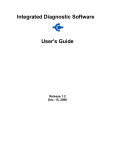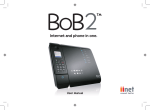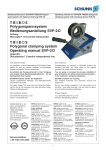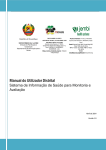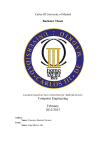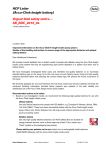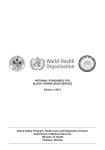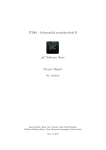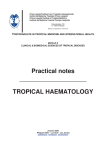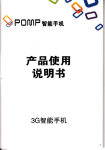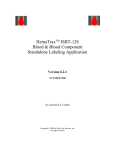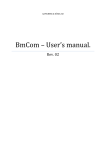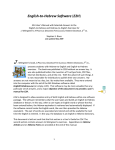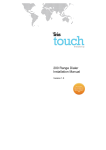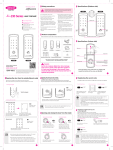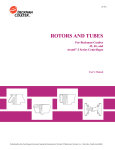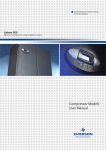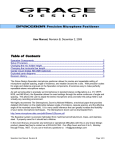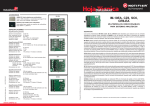Download Requirements Definition for Version 1.0 of BSIS Document Control
Transcript
Requirements Definition for Version 1.0 of BSIS Project: Blood Safety Information System Programme: Blood Safety Systems Strengthening Document Control Version 0.1 Description of Change Initial draft based on project team CT meeting Author Rob Wilkinson, Brian Gibbs, Pete Zacharias, Linda Taylor, Daniel Futerman, Carolyn Smith Date 02/07/2013 0.2 Added additional information based on team discussion Linda Taylor 20/08/2013 0.3 Added additional information based on team discussion Linda Taylor 17/09/2013 0.4 Updated based on requirements for the workshop demonstration and feedback from workshop participants Linda Taylor, Rob Wilkinson, Daniel Futerman 06/12/2013 0.5 Updated based on requirements workshop Rob Wilkinson, Daniel Futerman, Linda Taylor, Carolyn Smith 24/01/2013 0.5.1 Updated following feedback from project team Pete Zacharias, Brian Gibbs 14/02/2014 0.5.2. Added more detail after milestone review and after gap analysis with the LBTS user requirements Linda Taylor – reviewed by BSIS technical team 22/08/2014 Page | 1 Table of Contents 1. 2. 3. Introduction ..................................................................................................................................... 3 1.1 Purpose ................................................................................................................................... 3 1.2 Project Scope .......................................................................................................................... 3 1.3 Abbreviations and acronyms .................................................................................................. 4 1.4 References............................................................................................................................... 4 Overall Description .......................................................................................................................... 5 2.1 System Overview..................................................................................................................... 5 2.2 Guiding Principles ................................................................................................................... 7 2.3 User Classes and Characteristics ............................................................................................. 8 2.4 Operating Environment .......................................................................................................... 8 2.5 Documentation ....................................................................................................................... 9 2.6 Assumptions and Dependencies ............................................................................................. 9 Functional Requirements of the System ....................................................................................... 10 3.1 FR-01 Management of Donors .............................................................................................. 10 3.2 FR-02 Management of Donations ......................................................................................... 13 3.3 FR-03 Blood Testing Process ................................................................................................. 14 3.4 FR-04 Component Preparation Process .................................................................................... 15 3.5 FR-05 Management of Component Labelling............................................................................ 16 3.6 FR-06 Management of the distribution and issue of blood ...................................................... 18 3.7 FR-07 Configuration by Administrator and Super user ............................................................... 19 3.8 FR-08 Management Reporting Requirements ............................................................................ 24 4. Other Non-functional Requirements ............................................................................................. 28 4.1 Performance Requirements .................................................................................................. 28 4.2 Security – Authorisation, Auditing and Logging Requirements ............................................ 29 4.3 Other Requirements ............................................................................................................. 29 Appendix A: A detailed description of the workflow supported by BSIS .......................................... 32 Appendix B: Terminology used within BSIS ....................................................................................... 32 Page | 2 1. Introduction In May 2013, a low-cost blood establishment computer software (BECS); hereafter referred to as Blood Safety Information System (BSIS) was spun-off to Jembi Health Systems NPC (Jembi) from the Computing for Good (C4G) course at the Georgia Institute of Technology in Atlanta, GA. Faculty and students from C4G had led the research-and-development phase of V2V, the initial version of BSIS, since 2007. During the R&D phase, Georgia Tech consulted frequently with end-users in a number of African countries, including Zambia, Cameroon and Namibia. Additional technical assistance was provided to Georgia Tech by BECS experts from South Africa. The decision to spin-off V2V (now BSIS) was made by CDC, in conjunction with Georgia Tech, when it became clear that V2V was approaching a level of technical sophistication that could allow it to undergo final development in a simulated field environment, and, eventually, pass an external validation phase and be implemented in working blood services. 1.1 Purpose The aim of this document is to capture, define and document the functional and non-functional requirements for BSIS (Blood Safety Information System) from various stakeholders. 1.2 Project Scope The Blood Safety Strengthening Programme (BSSP) is the programme built around the development of the BSIS software to a production level and the implementation of the BSIS software in national blood services in countries in Africa. The programme looks at the implementation of the BSIS software as more than the simple deployment of the system at site, taking a whole system approach that acknowledges the interconnection between policy, practice and technology and looks at: Environment (where will the system be used?); Process (how will the system be used?); Technology (what hardware/software will be used?); Capacity building (who will use the system?), and; Sustainability (how much will it cost and who will pay?). The aim is to implement an effective and sustainable eHealth system that facilitates the achievement of improved blood safety and availability in countries in Africa. As such BSIS is not simply a software intervention but part of a larger programme strategy to improve quality management in low resource blood services in Africa. Page | 3 1.3 Abbreviations and acronyms AHG BSIS BECS BP BP Systolic BP Diastolic BC Cryo DIN ELISA FBC Hb Hct NBTS Plts RBC Rh SOP TTI VNRD WBC Anti-human Globulin Blood Safety Information System Blood Establishment Computer System Blood pressure Blood Pressure Systolic Blood Pressure Diastolic Buffy Coat Cryoprecipitate Donation Identification Number Enzyme-linked immunosorbent assay Full Blood Count Haemoglobin Haematocrit National Blood Transfusion Service Platelets Red blood cells Rh Standard Operating Procedure Transfusion Transmissable Infections Voluntary non-remunerated donors White blood cells 1.4 References 1. Blood donor selection: guidelines on assessing donor suitability for blood donation. (WHO 2012) 2. AfSBT Step-Wise Accreditation Standards (Africa Society for Blood Transfusion, 2013) 3. ISBT 128 For Blood Components An Introduction (ICCBBA 2011) 4. ISBT Guidelines for Validation of Automated Systems in Blood Establishments (ISBT Science Series 2010) 5. United States Industry Consensus Standard for the Uniform Labelling of Blood and Blood Components Using ISBT 128 (ICCBBA Version 2.0.0 2005) 6. WHO guidelines on good manufacturing practices for blood establishments (WHO Technical Report Series, No. 961, 2011) 7. WHO Aide memoire – Safe Blood Components (WHO 2005) Page | 4 2. Overall Description 2.1 High Level Functional Overview Page | 5 Page | 6 2.2 Guiding Principles o o o o o o o o o o o o o o o o o That the systems will positively impact blood safety through the reduction of errors in the donor clinic and in the laboratory. That the system is developed as an open-source system with the aim of developing a community of practice to support the on-going development in the long-term That the system will facilitate development of blood services and improvement in operational behaviour of implementing blood services. That the adoption of the software advocates and encourages the use of best laboratory and clinical practices, and that some workflow and system changes in the laboratory and the clinic may well have to precede the introduction of the software. That the system accounts for WHO and AfSBT guidelines and standards where appropriate. That the system is stable, reliable and easy to use. That the use of barcodes improves the speed and accuracy of data collection. That the workload, overall, is reduced and not increased. That the system provides the tools for improved management of donor and laboratory activities. That the system will assist the service in meeting the requirements of accreditation. This will allow for a fail-over paper-based system and will enable back entry of certain data. A mechanism will be provided to allow import of legacy data where possible and where appropriate. That the system will allow for some level of configuration according to the needs of the blood service. That the system will eventually allow for internationalisation with an initial focus on providing English, Portuguese and French support. The initial version 1.0 will only support English. The system will provide auditing across all major functions. The system will provide for role-based access. This system is focused specifically on low-resource settings with their inherent challenges. The system will be strengthened to ensure it is scalable and production-ready for these lowresource environments. System Scope The following areas of functionality are out of scope for Version 1.0 of the system: 1. 2. 3. 4. 5. 6. 7. 8. 9. 10. 11. Stock Costing & Billing Internationalisation Portuguese and French Language versions Waste Management Process Automation of Donor Communications ISBT128 support except for ISBT128-compliant labels Donor retested plasma Plasma for fractionation Cross-matching Additional / enhanced reporting Interfacing with testing equipment Supply chains Page | 7 2.3 User Classes and Characteristics The required classes of users are: 1 User Class Donor clinic staff 2 Donor clinic supervisor 3 Donor Counsellor 4 5 Donor Communications Donation testing staff 6 Donation testing supervisor 7 8 Component laboratory staff Component laboratory supervisor 9 Blood bank staff 10 Inventory Staff 11 Medical Officer 12 Data Clerk 13 BSIS Administrator 14 Super user Characteristics Access limited to donor information and donor processes only Access to confidential comments. Can drill down to previous donation data. Correction of some specified clinic data. Access to TTI results. Can link TTI results to specific donors Access to donor information Access limited to donation information and testing processes Access to printing and checking of laboratory results. Release of tested units for labelling. Correction of some laboratory data. Access limited component processing Access to reversing component preparation and correction of some laboratory data Cross-matching and issuing Labelling and transfers Access to donor information and their associated test results. Access to patient data, hospital blood usage, statistical reports. Access to enter / edit donor demographic data Access to all functions within the system with limited access to configuration and set-up (limited to two individuals) Administrators can create users except for other Administrators and Super users Full access to whole system (Limited to two IT Technical Support Staff and Jembi Health Systems IT Technical Support Staff as authorised by the NBTS.) Can create users except for other Administrators and Super users 2.4 Operating Environment The BSIS system is designed to run as a Java web-based application, ensuring platform independency, and will run across operating systems with a modern web browser (e.g. Chrome, Firefox) and Java installed. The system will be installed using the client-server model, so that clients do not have to install the application, but access this over a closed local-area network, or a more distributed widearea network, where network and infrastructure resources are appropriate and available. This design allows for simpler deployment and updates, adaptability to mobile access, and broader access than desktop applications (but with strict access control mechanisms to provide role-based access as required). Page | 8 With this model, the hardware requirements necessitate high-spec server(s) that are able to manage the client request loads; this will vary according to the needs of each implementation. The system is designed to allow for the use of barcode scanners, and pack label and barcode printers, and should work with any modern barcode scanner and label printers supporting the Zebra Programming Language (ZPL). Materials used must be suitable of use in a Blood Safety environment. 2.5 Documentation A set of User Manuals intended for use by the end-users of the system o Donations User Manual o Laboratory User Manual o Administration Manual A Technical Manual intended for system administrators to manage the system on an on-going basis An Implementation Manual to provide guidelines and checklists for the deployment, training, support and change management process A set of standard operating procedures (SOPs) describing the user interaction with the system. These SOPs will differ according to local procedures and will be developed in conjunction with each facility. A document providing an overview of the system functionality Requirements documentation Technical specifications 2.6 Assumptions and Dependencies That there is an existing quality management system That the national programme and their technical assistance provider will update the SOPs to reflect the use of BSIS These requirements are for a single instance of the system running in a central blood service. The ability to directly import from automated blood grouping and TTI testing equipment is highly dependent on the implementation environment so is excluded from system scope and will be dealt with as an implementation activity A minimum infrastructure o Stable power supply with UPS That the administrator of the BSIS system is available and has the requisite IT and blood safety skills to administer the system That English will be the first language available but that there will be a need for internationalisation in later versions That all staff will undergo go training and change management interventions as part of the installation Page | 9 3. Functional Requirements of the System 3.1 FR-01 Management of Donors Use Case References: BSIS User Story–Donor and Donation Management BSIS-UC01-001-Register a New Donor BSIS-UC01-002-Search and Update Donor Record BSIS-UC01-003-Manage Donor Codes BSIS-UC01-004-Manage Deferrals BSIS-UC01-007-Produce Donor Communications List BSIS-UC01-008-Check Donor Eligibility FR01 FR01-001 FR01-002 Management of Donors The system must be able to register a new donor and each donor shall be identified using a unique identifier (Donor Number) generated by the system. This Donor Number will not be editable; remains linked to the same individual throughout, and must never be deleted. The following mandatory data fields WILL be captured for each donor at the time of the first donation: First Name Last name Gender o Options= Male/Female Date of birth - with estimated checkbox The following additional non-mandatory demographic and other data fields MAY be captured for each donor: such as: Title (Mr, Mrs, Miss Etc.) Calling Name Date of First donation (this can only be captured when the new record is created but cannot be edited later. The system will update this automatically whenever a new donation is linked to this donor) Identifier Type o (options = National ID/Passport/(Driver’s) Licence No) Identifier Number Preferred Language Mobile telephone number Home telephone number Work telephone Email address Preferred Contact Method o (options= None, Telephone, SMS, Email, Mail, Do not contact) Donor Panel o (A Donor can only belong to one panel at a time but may change from one panel to another.) Home address o Address 1 o Address 2 o City o District o Province o Country o Zip or Postal Code Postal address o Address 1 o Address 2 Page | 10 FR01-003 o City o District o Province o Country o Zip or Postal Code Work address o Address 1 o Address 2 o City o District o Province o Country o Zip or Postal Code Preferred Address Type Notes (a general text field) The donor clinic staff user will be able to assign donor codes which could be updated according to results captured during the donation or during the testing process. Donor codes determine whether a donor can donate in the future or not. -001 Donor codes will be grouped by Donor Code Group and only the Donor Code Group will be displayed to donor clinic staff. The detail related to the donor code may contain confidential information and so will only be available to authorised users. -002 Valid Donor Code Groups with associated Donor Codes: 1. Do Not Bleed a. Biological False Positive b. For counselling HCV c. For counselling HIV d. For counselling HBsAg e. For counselling Syphilis f. Not counselled HCV g. Not counselled HIV h. Not counselled HBsAg i. Not counselled Syphilis j. Counselled HCV k. Counselled HIV l. Counselled HBsAg m. Counselled Syphilis n. High Risk (e.g. intravenous drug user) 1. Test Only a. b. c. d. e. f. g. h. i. TTI confirmation HCV TTI confirmation HIV TTI confirmation HBsAg TTI confirmation Syphilis Antibody Identification Blood group confirmation Possible donor misidentification Test specimen broken / Insufficient specimen Positive DAT Page | 11 -002 FR01-004 These Donor Codes and Donor Code Groups must be editable by the Super user. The system will allow for the management of donor deferrals through the use of configurable deferral codes with associated deferral periods based on WHO and country-defined standards. This process is a manual process determined by the users. -001 Deferral reasons will include the following based on WHO guidelines: Low weight Low haemoglobin Other medical conditions High risk behaviour Travel history Other reasons -002 -003 FR01-005 FR01-006 FR01-007 FR01-008 Other deferral reasons may be added by an Super user The supervisor may be authorised to override some deferrals under certain circumstances and under the authority of the medical officer and if so, this is logged. Deferral history will be retained. The system shall provide the ability to synchronise donor and donation data between the laptop computers used in mobile clinics and the main central database -001 The system shall provide the ability to synchronise donor and donation data to laptop computers for use in mobile clinics -002 The system shall provide the ability to synchronise the updated donor and donation data from laptop computers used in mobile clinics back into the main central database The system must provide the ability to search for a donor -001 By donor number, first name, last name -002 By DIN (Donation Identification Number) The system will provide a printable list of donors for donor communications purposes filterable by Donation site / Donor panel Donors due to be bled on Date of Clinic Donors who last donated between two dates Blood group The system will check each donor against the following criteria to determine if they are eligible to donate: -001 New donor Check donor age is within allowable range as configured by the Administrator. -002 Repeat donor Check interval since last donation and that this conforms with Administrator-configured interval Check that donor has not been coded “Do Not Bleed” Check that the donor is not currently deferred Check donor age is within allowable range as set by the Administrator. Page | 12 3.2 FR-02 Management of Donations Use Case References: BSIS User Story-Donor and Donation Management BSIS-UC02-003-Open & Close Donor Clinic BSIS-UC02-004-View Donation Batch BSIS-UC02-005-Link Donor and Donation FR02 FR02-001 FR02-005 FR02-002 FR02-003 FR02-004 Management of Donations A unique pre-printed Donation Identification Number (DIN) will be allocated to the donation. This DIN and the Donor Number will be irreversibly linked to ensure that the donation unit is always traceable back to the donor who provided it. The system will be able to capture and store the following data fields for each donation: Donation Identification Number Donor Number Date Bled Venue Pack Type Pack Weight Donation Batch Number Donor’s ABO Group Donor’s Rh Group Donor’s Haemoglobin Donor’s Systolic Blood Pressure Donor’s Blood Pressure Donor’s Pulse Donor’s weight Donation comment The system will be able to group donations into Donation Batches and should generate a unique identifier for each Donation Batch Donation Batches should be searchable by: 1. Donor Panel 2. Date Period 3. DIN Page | 13 FR-03 Blood Testing Process FR03 FR03-001 Management of the Blood Testing Process The system will provide for ABO, Rh and other serology tests with results as follows: A Negative; FR03-002 The system will provide for TTI tests as follows: FR03-003 FR03-004 FR03-005 FR03-005 FR03-006 FR03-007 FR03-008 FR03-009 A Positive; AB Negative; AB Positive; B Negative; B Positive; O Negative; O Positive; No Sample (NS); Not Tested (NT). HIV Hepatitis B Hepatitis C Syphilis The system will provide the following result types: Negative; Positive; No Sample (NS); Not Tested (NT). The system will make provision for the addition of additional tests such as the screening for unexpected antibodies, screening for malaria parasites, etc. The system will be able to capture all test results by manual entry using the following methods: -001 Blood group serology carried out in micro titre plates or test tubes. Agglutination results will be captured according to the strength of the reaction (0, 1,2,3,4, H) -002 TTI test outcomes will be entered -003 Worksheets can be printed to show the position of test specimens if the testing is done manually. The system will be able to capture TTI test results via an import of a file containing test results from an automated instrument -001 The system will be able to import an Excel spread sheet file containing TTI test result information in a specified format matching the BSIS data model The system will be able to interpret blood group serology and TTI test results according to a defined algorithm and record the final test outcome The system will provide traceability of test outcomes by testing batch. A testing batch is defined as - All units tested during a single test run within the testing laboratory. The system will be able to determine the need for additional or repeat tests based on defined criteria The system will automatically flag and block donation units based on defined test outcomes Page | 14 FR03-010 FR03-011 FR03-012 FR03-013 The system will automatically do a comparison with ABO-Rh test outcomes from previous donations from the same donor and will flag any discrepancies allowing confirmatory testing to resolve a mismatch The system will allow for entry of confirmatory blood group serology outcomes for first time donors The system will provide the facility for an overview of all test batch results (including repeat tests) and/or test outcomes to be viewable on screen, as well as being able to view the test result detail of an individual donation unit. The system will provide the facility for all test results in a test batch to be printed so that the results can be checked and signed off 3.4 FR-04 Component Preparation Process FR04 FR04-001 FR04-002 FR04-003 FR04-004 FR04-005 Management of the component preparation process The system will be able to capture component preparation data with full traceability retained throughout The system will provide for the splitting of blood components as specified: -001 The system will provide for the splitting of whole blood into between 2 and 5 paediatric units. The number of units prepared must be user-selectable. -002 The system will provide for the splitting of whole blood units into red cell concentrate (RCC), buffy coat, plasma or a subset of components. -003 The system will provide for further splitting of fresh frozen plasma (FFP) and red cell concentrate (RCC) into between 2 and 5 paediatric units. The number of units prepared must be user-selectable. -004 The system will provide for splitting of apheresis platelet units into a combination of adult and paediatric units. The number of units and the combination must be user selectable. The system will allow for the pooling of specified components as specified: -001 The system will provide for pooling of between 2 and 5 platelet concentrate units. The number of units pooled must be user-selectable. -002 The system will provide for pooling of between 2 and 5 cryoprecipitate units. The number of units pooled must be user-selectable. Components should be searchable by: 1. DIN 2. Component Type Each components will have a Component Status that is automatically assigned and which flags the status of each individual component as follows: Quarantined (This is the default status of each component – this includes whole blood. Quarantined donations cannot be labelled for release) Processed (This means the original component such as whole blood has been split into components and therefore does not exist anymore) Unsafe Issued Transferred Expired Labelled (In stock and can be issued) Page | 15 Fr04-006 NOTE: The status of the donation is different to the status of the components e.g. when one component unit has been discarded due to breakage but all other components have not Components should be filterable by Component Status when viewing on screen 3.5 FR-05 Management of Component Labelling FR05 FR05-001 FR05-002 FR05-003 FR05-004 FR05-005 FR05-006 FR05-007 FR05-008 FR05-009 FR05-010 FR05-011 Management of Component Labelling The labelling of a component is a control point which determines whether that component is able to be released for use or must be discarded. (See 3.5.1. for a description of the algorithm at this control point) Components that have been fully tested with all discrepancies resolved are automatically flagged as Safe and a Final Pack Label can be printed. Components flagged as Quarantined (due to outstanding test results or discrepancies), Expired, Processed or Issued will not allow a final Pack Label to be printed. Components that form part of a donation where TTI Testing is flagged as Unsafe or Incomplete will not allow a final Pack Label to be printed. Components that form part of a donation where Blood Serology Testing is flagged as Incomplete, Ambiguous, Mismatch or No Type Determined, will not allow a final Pack Label to be printed. Components that form part of a donation where the Donor is flagged as deferred at the time of the donation, will not allow a final Pack Label to be printed. Components that form part of a donation where the Donor has a ‘Do Not Bleed’ Code Group associated with them, will not allow a final Pack Label to be printed. Components that form part of a donation where the Donation has a ‘Blood Group Issues’ Code Group or a ‘Bleed Issues’ Code Group associated with them, will not allow a final Pack Label to be printed. Components that have been manually flagged as Discarded will have a Discard/Biohazard label printed Only components where ALL the following is TRUE, will allow for a final Pack Label to be printed: Component is flagged as Available (i.e. ready for labelling) Component forms part of a donation where TTI Testing is flagged as TTI Safe Component forms part of a donation where Blood Group Serology Testing is flagged as Complete Component forms part of a donation where the Donor is NOT flagged as deferred at the time of the donation. Component forms part of a donation where the Donor does NOT have a ‘Do Not Bleed’ Code Group associated with it. Component forms part of a donation where the Donation does NOT have a ‘Blood Group Issues’ Code Group or a ‘Bleed Issues’ Code Group associated with it. Component has not been flagged as Discarded The Final Pack Label will incorporate standardised information about the donation unit. The following information must be printed on the pack label and each piece of Page | 16 information should have an eye-readable barcode printed as well where it is a date or an identifier 1. 2. 3. 4. 5. FR05-012 DIN ABO/RH blood group Collection date (Optional) Component Code Expiration Date (and time where relevant) 6. Special Testing (Optional) The Discard / Biohazard labels will incorporate standardised information about the donation unit. 3.5.1. The Component Labelling Process (Validation of all conditions including test results and outcomes to ensure the pack is safe for release) The system will check the following – The ABO and Rh on the Donation and the ABO and Rh on the Donor record o These will be compared. If not identical, this pack cannot be labelled The ABO and Rh on the previous donation if a repeat donor; or the Repeat ABO and Rh if a first time donor o These will be compared with the ABO and Rh on the present donation and if not identical, this pack cannot be labelled The donor record must be checked to see if the donor was deferred at the time of the donation, or if there is any reason why the component may be used even if the donor was deferred at the time of donation. If the Component Status is o Quarantined o Processed o Unsafe o Issued o Transferred o Expired Then the pack must not be able to be labelled Non-Reactive outcomes will be recorded for the following TTI markers on both the present donation and the previous donation (if a repeat donor) – o Anti-HIV o Anti- HCV (if stipulated by the Administrator) o HBsAg o Syphilis test o Any other TTI stipulated by the Administrator o Any confirmatory screening tests o Any other pending tests If and only if ALL of these outcomes are Non-Reactive can the pack then be labelled If any of these outcomes are Reactive, Inconclusive or missing, then the pack cannot be labelled Non-Reactive outcomes will be recorded for the following ABO-Rh tests on both the present donation and the previous donation (if a repeat donor) – o If and only if ALL of these outcomes are Non-Reactive can the pack then be labelled Page | 17 o If any of these outcomes are Reactive, Inconclusive or missing, then the pack cannot be labelled The Antibody screening test – if this is Reactive then this pack should not be able to be labelled but can be over-ridden by the supervisor because: o o o o Antibody screen – if this is Reactive for a clinically important antibody Then this unit must be sent for further testing is to determine the antibodies And then the results are interpreted by the supervisor to see if the unit can be used This requires a manual decision by the supervisor 3.5.1.3. Discard Label If the donation fails to meet the requirements of the Component Labelling Process and is rejected as being unsafe for use then the system will generate a label that indicates that this is a bio-hazard and is unfit for use. This will include standardised information. 3.6 FR-06 Management of the distribution and issue of blood FR06 FR06-001 FR06-002 FR06-003 FR06-004 FR06-004 FR06-005 Management of the distribution and issue of blood The system shall provide the ability to have full traceability of all components from donor to patient, where the patient information is available. The system shall provide full traceability of units discarded or not issued or not transferred The system will provide the facility to manage requests for blood units at an individual patient level. -001 The system will provide the ability to add, view and edit (only prior to issue) an Individual Request -002 Mandatory information required when adding a new Individual Request is: Patient Identifier Site (Authorised facility such as a hospital or clinic) Cross match type (e.g. emergency) Date of request Requested components -003 Additional information that can be captured when adding or editing a new Individual Request is: Patient demographic data and blood type and diagnosis and cross match information Site/Facility information Other information such as Requested By -004 The system will provide the facility to search for and track the Request using date period, type, site, as well as a filter to include fulfilled requests if needed. The system shall allow for the ability to track the movement of blood units transferred to authorised facilities and subsequent transferrals between facilities The system will provide the facility to manage Transfers of blood units to an authorised facility i.e. hospital Page | 18 -001 FR06-006 FR06-007 The system will provide the ability to add, view and edit (pending issue only) a Request -002 Mandatory information required when adding a new Request is: Site (Authorised facility such as a hospital or clinic) Date of request Requested by Requested Components The system will provide the ability to print the Transfer or Issue Summary (Packing List) which includes information from the request form and the issued components When components are transferred or issued the pack status is updated 3.7 FR-07 Configuration by Administrator and Super user The following parameters are configurable within the system in order to meet local requirements. FR07 FR07-001 FR07-002 FR07-003 FR07-004 Configuration There are two levels of configuration of the system. 1. One is at the level where only a Super user is able to set or change parameters. This will be part of the initial installation of the system when it will be configured according the national blood service needs and will include those settings which will be very unlikely to change over time. 2. At the second level parameters can be set and changed by a BSIS Administrator. Configuration and initial set-up by Super user The system shall provide the ability for the Super user to configure the following parameters in order to meet local requirements: Role-based user access (see 2.3 User Classes and Characteristics for a list of standard roles) -001 The Super user should be able to add a new role and assign permissions to that role -002 The Super user should be able to edit an existing role Global Properties should only be configurable by a Super user. These are: Donor Code Groups and Donor Codes Donation Code formats Donor minimum age Donor maximum age Number of days between consecutive donations – Whole blood Number of days between consecutive donations – Apheresis Valid combinations of components that can be separated from other components should be defined by the super user. Standard combinations are: Separated from Whole Blood: Red cells 1-1 Fresh Frozen Plasma 1-1 Platelet Rich Buffy Coat 1-1 Paediatric Whole Blood (2 – 5 units) Separated from Red Cells Paediatric red cells (2 – 5 units) Separated from Fresh Frozen Plasma Paediatric Fresh Frozen Plasma (2 – 5 units) Page | 19 FR07-005 FR07-006 FR07-007 It should be possible to pool units of the following components (pools of 2 – 5 units) Platelets Cryoprecipitate Blood Tests – Standard blood tests provided in the system (which may be set to “inactive” if not required). The super user may add additional tests. 1. Blood Group Serology Anti-A Anti-B Anti-A, B A1 cells A2 cells B cells Cells Anti-D – saline Anti-D – enzyme Anti-D – AHG Antibody screen – enzyme Antibody screen – AHG DAT Haemolysin 2. TTI-Tests Anti-HIV Anti-HCV HBsAg TPHA VDRL Malaria screen Blood typing rules – Super user only Lab set-up – Super user only -001 The Super user should be able to select the method for Blood Group Serology from a pre-defined list: Testing in ELISA plates with manual entry of test results Testing in test tubes with manual entry of test results using worksheets -002 FR07-008 FR07-009 The Super user should be able to select the method for TTI testing from a pre-defined list which includes: ELISA testing with manual entry of test outcomes ELISA testing with electronic transfer of test outcomes Internationalisation This functionality will not be available in Version 1.0 but will be available in later versions Configuration by BSIS Administrator The system shall provide the ability for the BSIS Administrator to configure the following parameters in order to meet local requirements: Role-based user access (see 2.3 User Classes and Characteristics) -001 The BSIS Administrator should be able to add a new User and assign a Role to that User which will inherit permissions associated with that Role -002 The BSIS Administrator should be able to edit an existing User Page | 20 -003 FR07-010 The BSIS Administrator should be able to remove an existing User who will no longer then be able to access the system. The record will be retained as a voided record for audit purposes. -004 The BSIS Administrator should be able to assign and manage/re-set passwords associated with the User. -005 The BSIS Administrator should not be able to create a super user or additional administrators The BSIS Administrator should be able to create Code Groups and Codes and associate Codes to Code Groups -001 Code Groups Do Not Bleed Test Only Blood Group Issues -002 FR07-011 FR07-012 Codes TTI Positive For Counselling Blood Group Mismatch Pending 2nd blood group test results The Administrator should be able to create and edit Deferral information as follows: -001 -002 Deferral Reasons for which a donor may be deferred o Low weight o Low haemoglobin o Other medical conditions o High risk behaviour (permanent) o Travel history o Other reasons Deferral Periods – the time period for which donors may be deferred The Administrator should be able to create the following sites: -001 Centre Types of centres based on the WHO definition are: o Collection o Testing o Processing o Distribution -002 Donation Site (same as a Donor Panel) The following will be provided as standard: o Fixed site o School o Community Centre o Church o Factory / business o Service Club (e.g. Rotary Club) o Other mobile o Shopping Centres Page | 21 -003 FR07-013 Request / Usage Site The following will be provided as standard: o Hospital o Blood Bank o Centre Pack Types - The Administrator should be able to define the Pack Types. The following are provided : FR07-014 FR07-01 Single Triple Quad Apheresis Apheresis twin-pack Dry Pack No Pack Used The Administrator should be able to manage component types and component combinations which may be made by splitting a unit of whole blood. -001 Component Types will include: NB: Names from “United States Industry Consensus Standard for the Uniform Labelling of Blood and Blood Components Using ISBT 128 - Version 2.0.0 – November 2005”. Note that very few of these products will be prepared in most BTSs and if not in use will be flagged “Inactive”. Each type will be associated with an expiry period. Whole blood Red blood cells Washed red blood cells Frozen red blood cells Frozen rejuvenated red blood cells Deglycerolized red blood cells Deglycerolized rejuvenated red blood cells Rejuvenated red blood cells Apheresis red blood cells Fresh frozen plasma Thawed fresh frozen plasma Recovered plasma Apheresis fresh frozen plasma Thawed apheresis fresh frozen plasma Apheresis plasma Source plasma Thawed apheresis plasma Liquid apheresis plasma Plasma Thawed plasma Liquid plasma Platelet-rich plasma Platelets Washed platelets Pooled platelets Washed pooled platelets Apheresis platelets Page | 22 FR07-015 FR07-016 FR07-017 FR07-018 FR07-019 Frozen apheresis platelets Thawed apheresis platelets Washed apheresis platelets Cryoprecipitate Thawed cryoprecipitate ahf Pooled cryoprecipitate ahf Thawed pooled cryoprecipitate ahf Apheresis cryoprecipitate ahf Thawed apheresis cryoprecipitate ahf Granulocytes Apheresis granulocytes Pooled granulocytes Apheresis granulocytes/platelets Leukocytes Apheresis leukocytes Pooled plasma Liquid apheresis plasma Washed apheresis red blood cells Frozen apheresis red blood cells Deglycerolized apheresis red blood cells Rejuvenated apheresis red blood cells Frozen rejuvenated apheresis red blood cells Deglycerolized rejuvenated apheresis red blood cells Platelet-rich buffy coat Purchased components This forms part of the Distribution and Issue Process and will only be available in Version 2 This refers to components not produced by the BTS, e.g., ‘fractionation components’. These can be listed by the Administrator if they are managed by the blood service. The Administrator should be able to set the Cross-Match Type that may be requested. The following are provided: Group and Screen None Emergency Standard Can we remove this for version 1 and say only available in version 2 ? The Administrator should be able to set the type of Cross-Match Tests Can we remove this for version 1 and say only available in version 2 ? The Administrator should be able to set the Diagnoses codes for which blood may be requested Use of standard IPC codes (50+) ICD9 or ICD10 codes Other Can we remove this for version 1 and say only available in version 2 ? The Administrator should be able to define Reasons for Discards. These should include the following based on WHO categories: Incomplete Donation Reactive for TTIs o HIV o HCV o HBV Page | 23 FR07-020 The Administrator should be able to define the Donor Types of a particular donation based on the status of the donor at the time the donation was given. The following are provided FR07-021 o Syphilis o Other Passed Expiry Dates Storage Problems Transport Problems Processing Problems Voluntary, non-remunerated donors (VNRD) Family replacement donors Paid donors Autologous Other The Administrator should be able to define the Donation Category based on the status of the donor at the time the donation was given. The following are provided – First time donor Repeat Donor Lapsed Donor 3.8 FR-08 Management Reporting Requirements Management reporting produces information to enable better planning and to meet organizational and national reporting needs. FR08 FR08-001 FR08-002 FR08-003 Management Reporting Requirements All reports should be printable, with the option to export to other software such as PDF or Excel. Donors due to be bled report Used for the Donor Communication Process - operational printout (Daily) (Text based PDF) Header to contain – Report name, panel name and location, date printed, filters in place. Details required - full name, blood group, home and business telephone numbers, email address, comments. Exclude deferred and coded donors as DO NOT BLEED. Pages to be numbered. Sorted into alphabetical order (Last name, First name) or by telephone number. Filtered by selection as follows: o Site o Blood group o Date of last donation (i.e. last donation between two selected dates) Print the barcode DONOR NO Count of components discarded report (Monthly) Include graphs Printable PDF Header to contain – Report name, date printed, Start date and End date. Details required: Page | 24 o o o FR08-004 FR08-005 FR08-006 FR08-007 FR08-008 Component type, number of units discarded for each reason in the “Discard Reasons” table. Drill down possible to actual unit details. Filtered by selection as follows: Start and end dates for time period Processing facility/ Centre Units of blood collected report Used in the Donations Process – operational printout (Daily) export to Excel or print graphs, Printed PDF Header to contain – Report name, date printed, Start date and End date. Details required – counts for each donor type (voluntary, family replacement etc.), type of pack, blood group. Filtered by selection as follows: o Start and end dates for time period o Collection Site (Type of Venue (School, Factory, Fixed site etc.)) TTI Prevalence report (Monthly) Printed PDF , export to Excel or print graphs Header to contain – Report name, date printed, Start date and End date. Details required – counts for each donor type (voluntary, family replacement, etc.), sub-divided into First time, lapsed, repeat donations, and for each TTI. Screen reactive and confirmed positives to be shown as separate counts. Filtered by selection as follows – o Start and end dates for time period o Collection Site (Type of Venue (School, Factory, Fixed site etc.)) Components Issued report. (Monthly) Printed PDF , export to Excel or print graphs Header to contain – Report name, date printed, Start date and End date. Details required – counts for each component issued by diagnosis, component type, and blood group. Filtered by selection as follows: o Start and end dates for time period o Component o Request/Usage site Components Transferred report. (Monthly) Printed PDF , export to Excel or print graphs Header to contain – Report name, date printed, Start date and End date. Details required – counts for each component transferred by component type, and blood group. Filtered by selection as follows: o Start and end dates for time period o Component o Request/Usage site Pack Audit report. (Monthly) Printed PDF , export to Excel or print graphs Header to contain – Report name, date printed, Start date and End date. Details required – list of all blood components (WB, RCC, FFP, etc.) that have not been issued or discarded, but have reached or passed the expiry date. Filtered by selection as follows: o Start and end dates for time period o Component Page | 25 FR08-009 FR08-010 o Date Bled and Expiry date o Location of component (Status) Report listing the Family Replacement Donors and their contact details ( phone numbers, email addresses) Part of Donor Communication Process- To be used for conversion of Family Replacement Donors to Non remunerated donors Based on the most recent donation from this donor (Monthly) Printed PDF Filtered by selection as follows: Start and end date WHO GDBS reporting protocol as a Printed PDF to be used to enter data on the excel spread sheet and an excel export (Every 6 months) The data required for this report, and available from BSIS, are listed here: (NB selectable for any time period by entering Start Date and End Date) Numbers shown are the reference numbers in the WHO GDBS2011 Report and the report generated by BSIS should reflect these numbers. 1.4 Start date and End date for the report 3.5.1 Total number of VNRD who donated during the time period 3.5.2 Total number of Family Replacement Donors who donated during the time period 3.5.3 Total number of Paid Donors who donated during the time period (based on most recent donation within the period reported) 3.5.4 Total number of Donors who donated Whole Blood during the period (3.5.1.-3.5.4. excludes autologous) 3.6.1 Number of WB units collected from VNRD during the time period 3.6.1.1 Number of WB units collected from First-time VNRD during the time period 3.6.1.2 Number of WB units collected from Repeat VNRD during the time period (includes lapsed donors) 3.6.2 Number of WB units collected from Family replacement donors during the time period 3.6.3 Number of WB units collected from Paid donors during the time period 3.6.4 Number of WB units collected from Other donors during the time period (specify type of donors) 3.6.5 Total number of donations collected during the time period 3.7 Are any donations collected through Apheresis (Yes or No) 3.7.1 Number of Apheresis procedures involving VNRD during the time period 3.7.1.1 Number of Apheresis procedures involving First-time VNRD during the time period 3.7.1.2 Number of Apheresis procedures involving Repeat VNRD during the time period 3.7.2 Number of Apheresis procedures involving Family replacement donors during the time period 3.7.3 Number of Apheresis procedures involving Paid donors during the time period 3.7.4 Number of Apheresis procedures involving Other donors during the time period (specify type of donors) Page | 26 3.7.5 Total number of Apheresis procedures during the time period 3.8.1 Number of donors permanently deferred during the time period 3.8.2 Number of donors temporarily deferred during the time period Number of donors deferred because of – o 3.9.1 Low weight o 3.9.2 Low haemoglobin o 3.9.3 Other medical condition o 3.9.4 High risk behaviour o 3.9.5 Travel history o 3.9.6 Other reasons (Specify) o 3.9.7 Total number of deferrals 3.10.1 Number of WB Donations from Male donors 3.10.2 Number of WB Donations from Female donors 3.11.1 Number of WB Donations from donors aged under 18 3.11.2 Number of WB donations from donors aged 18 – 24 3.11.3 Number of WB donations from donors aged 25 - 44 3,11,4 Number of WB donations from donors aged 45 - 64 3.11.5 Number of WB donations from donors aged over 65 3.12 Number of autologous blood donations 4.5.1 Number and % of WB and Apheresis donations tested for HIV 4.5.2 Number and % of WB and Apheresis donations tested for HBV (HBsAg) 4.5.3 Number and % of WB and Apheresis donations tested for HCV 4.5.4 Number and % of WB and Apheresis donations tested for Syphilis 4.5.5 Number and % of WB and Apheresis donations tested for Chagas Disease 4.5.6 Number and % of WB and Apheresis donations tested for Malaria 4.5.7 Number and % of WB and Apheresis donations tested for HTLV I/II 4.5.8 Number and % of WB and Apheresis donations tested for Other TTIs (Specify) 4.7.1 Number and % of donations screened reactive for HIV 4.7.2 Number and % of donations screened reactive for HBV (HBsAg) 4.7.3 Number and % of donations screened reactive for HCV 4.7.4 Number and % of donations screened reactive for Syphilis 4.7.5 Number and % of donations screened reactive for Chagas disease 4.7.6 Number and % of donations screened reactive for Malaria 4.7.7 Number and % of donations screened reactive for HTLV I/II 4.7.8 Number and % of donations screened reactive for Other TTIs (Specify) 4.8.1 Number and % of WB donations from VNRD screened reactive for HIV Number and % of Apheresis donations from VNRD screened reactive for HIV Total number and % of WB and Apheresis donations from VNRD screened reactive for HIV 4.8.1.1 Total number and % of WB and Apheresis donations from First Time VNRD screened reactive for HIV 4.8.1.2 Total number and % of WB and Apheresis donations from Repeat VNRD screened reactive for HIV 4.8.2 Total number and % of WB and Apheresis donations from Family replacement donors screened reactive for HIV Page | 27 4.8.3 Total number and % of WB and Apheresis donations from Paid donors screened reactive for HIV 5.2 Number and % of WB donations separated into components 5.3.1 Number of WB units separated into Red Cell Concentrate (Do not include any secondary separations e.g. paediatric RCC) 5.3.2 Number of WB units separated into Platelet Concentrate 5.3.3 Number of WB units separated into FFP 5.3.4 Number of WB units separated into plasma 5.3.5 Number of WB units separated into Cryoprecipitate 5.4.1 Number of units of Apheresis red cells collected 5.4.2 Number of units of Apheresis platelets collected 5.4.3 Number of units of Apheresis plasma collected 5.5. Number of WB/RCC discarded o 5.5.1 Incomplete blood donation o 5.5.2 Reactive for TTIs o 5.5.3 Expired o 5.5.4 Storage problems o 5.5.5 Transportation problems o 5.5.6 Processing problems o 5.5.7 Total number WB/RCC discarded 6.4.1 Number of WB units issued (actually units transferred) 6.4.2 Number of Red Cell Concentrate units issued 6.4.3 Number of WB derived Platelet units issued 6.4.4 Number of Apheresis derived platelet units issued 6.4.5 Number of FFP units issued 6.4.6 Number of Plasma units issued 6.4.7 Number of Cryoprecipitate units issued 6.5 Number of patients transfused 6.6 Number of patients transfused , by age o 6.6.1 Under 5 years o 6.6.2 5 to 14 years o 6.6.3 15 to 44 years o 6.6.4 45 to 59 years o 6.6.5 60 years and older 4. Non-functional Requirements 4.1 Performance Requirements NFR01 NFR01-01 NFR01-02 NFR01-03 Performance Requirements The system should be designed to store a minimum of 1,000,000 donor records The system should be designed to store a minimum of 4,000,000 donation (collection) records. Each of the donations may be processed into three separate components which will retain the same identification number as the original unit, meaning a total of 16,000,000 possible component records. Need to define system availability Page | 28 NFR01-04 Need to define actual performance i.e. response times, updates, retrieval and report generation 4.2 Security – Authorisation, Auditing and Logging Requirements NFR02 NFR02-001 NFR02-002 NFR02-003 NFR02-004 NFR02-005 NFR02-006 Security Requirements The system will provide role-based access restrictions based on User Classes defined in section 2.3. A maximum of two Administrator users is allowed. Only Administrator can create users and assign domains. All system transactions will be logged in an audit log with the date stamp, a time stamp, and the user-ID of the user. The audit log will never be deleted The system will provide for the secure storage and retrieval of passwords Additional security for laptop used for donor mobile clinics Database backups and disaster recovery Use of cloud-based technologies 4.3 Other Requirements NFR04 NFR04-01 Other Requirements Requirement to provide a standard import mechanism for legacy data. Existing donor and donation records, and test data from existing legacy systems will be imported into BSIS if possible and where appropriate. This will need to be determined on a case by case basis. 4.5 Minimum Hardware Requirements Server Processor - Intel Core 2 Duo or later At least 4 GB RAM 200 GB hard disk drive LAN Wired Ethernet – 100 Mbps Bandwidth Wireless Router – 802.11g Supported Workstation Laptop Processor - Intel Core 2 Duo or later At least 1 GB RAM 100 GB Hard Disk Drive Operating System - Windows 7 or later Browser – Firefox or Google Chrome Processor - Intel Core 2 Duo or later At least 1 GB RAM 100 GB Hard Disk Drive Operating System - ? Browser – Firefox or Google Chrome Printer Any printer supported by the Operating System Label Printer Thermo genic label printer using materials suitable for a blood safety Environment Page | 29 Barcode printer Barcode reader Data back-up system UPS protection A barcode printer that can be taken to a collection site for printing donor labels Barcode printer should be able to print barcodes encoded Code 128 barcode format A barcode reader with a USB connector which can scan Code 128 format barcodes An external storage device, e.g., External Hard Disk, with a USB connector which can be stored offsite. BSIS Software will provide backup and restore functionality – to be elaborated UPS should be available for servers, workstations and LAN devices to provide at least 15 minutes of power. Page | 30 Sign Off ____________________________ Name Organisation ____________________________ Name Organisation __________________ Date __________________ Date ____________________________ Name Organisation ____________________________ Name Organisation __________________ Date __________________ Date Page | 31 Appendix A: A detailed description of the workflow supported by BSIS Appendix B: Terminology used within BSIS A B TERM Apheresis ABR - Autologous transfusion Anti-human Globulin - Anti-coagulant ABO blood groups - Blood safety information system Blood Establishment Computer System Blood Group Serology BSIS AHG BECS blood grouping/ blood typing/ ABO Rh testing Blood typing rule Barcode Barcode label Blood Pack Blood pressure Synonyms BP EXPLANATION FOR TERM AS USED IN BSIS The process whereby whole blood is taken from the donor and then immediately processed to harvest a particular component. The donor is reinfused with those constituents of their blood that are not needed by the blood bank. An apheresis machine is used to carry out this process. (See plateletpheresis/ plasmapheresis) Withdrawal and subsequent return of blood to the same person. Reagent used to detect the presence of antibodies or complement binding to red blood cells. Substance used to prevent clotting of blood. One of the major blood group systems. The four main groups in the ABO system are A, B, AB and O The name of the BECS software system based on V2V and developed under the BSSP programme A computer system designed to assist in the management of donors, donations and allied aspects of a blood transfusion service. Identifying the blood group of a donation by serologic testing of a sample of blood. Also refers to the screening and identifying of unexpected antibodies. The algorithm used to determine a blood group based on test results. Part of the initial system configuration. An optical machine-readable representation of data relating to the object to which it is attached. Used in BSIS to make data entry faster and more accurate. Stick-on labels that may be pre-printed or generated by BSIS and are used throughout the blood chain to identify donations, components and donors. Plastic container into which a donation is collected. May consist of multiple parts into which components may be separated. Can also refer to the completed donation/ product. Measurement of the pressure exerted on the vessel walls by the blood during the active and resting phase of the heartbeat. Measured in mm of mercury and made up of Systolic and Diastolic measurements. Page | 32 TERM Blood Pressure Systolic ABR BP Systo lic Blood Pressure Diastolic BP Diast olic Synonyms Buffy Coat C Controls Component Product Components Laboratory Component type Product type Component code Product code Cross match Compatibility test Cryoprecipitate Cryo D The layer of white cells and platelets that is seen between the red cells and the plasma in a bag of whole blood that has been centrifuged. Samples with known results that are tested in parallel with, before or immediately after routine tests using the same environment, reagents and conditions as those of the test sample If these results do not fall into an acceptable range the test results are deemed invalid and the tests must be repeated. The therapeutic constituents of whole blood that are prepared by centrifugation and separation. The laboratory within the blood service which processes whole blood into components The various components and sub-components which may be processed from a blood donation Code used to describe the various component types. Includes: WB = whole blood RCC =red cell concentrate FFP= fresh frozen plasma Procedure whereby the donor red cells are mixed directly with the recipient plasma/ serum to detect ABO and/ or other red cell antigen compatibility. A plasma component prepared from frozen fresh plasma by slow thawing which is rich in Factor VIII. Centre Code Group Code Donor EXPLANATION FOR TERM AS USED IN BSIS Refers to the measurement taken when the heart is contracting in order to pump the blood around the body. This is the time when the arteries are under maximum pressure Refers to the measurement taken when the heart is relaxed between contractions. A blood service site which offers two or more of the following services: Donations(collections) Testing processing, distribution Blood donor The person who donates blood Page | 33 TERM Donor Code ABR Synonyms Donor Number Donor Type EXPLANATION FOR TERM AS USED IN BSIS A code assigned to the donor to indicate the current status of that donor according to results captured during the donation or during the testing process. A unique system-generated number used to identify the donor Donors are categorised into the following types for reporting purposes: Donation Donation Identification Number Donation site Collection DIN Collection site Donation testing laboratory Donation batch Donation category Collection batch The unit of blood, or blood component, drawn from the donor. May also refer to the act of withdrawing the blood or blood component from a donor A unique pre-generated number applied to the donation which links the donation to the donor and is also applied to any components resulting from this donation The place where the blood donations take place. May be either: Mobile site Fixed site The laboratory within the blood service where all blood group serology and TTI testing on blood donations is performed A batch consisting of one or more donations that were collected at the same donation site during the same session. Donations are categorized as being drawn from the following type of donor based on their status at the time of the donation: Date Bled Deferral Deferral reason Deferral period Department Voluntary, non-remunerated donors (VNRD) Replacement donors Paid donors Autologous Other First time donor Repeat Donor Lapsed Donor The day that the blood collection was made. Refers to delaying the donation from a donor. This may be temporary or permanent. The reason that the donor has been deferred. The period for which the donor has been deferred, after which the donor may donate. A department within a health facility Page | 34 TERM Donor Panel ABR Synonyms Diagnosis Discard Discard Label Biohazard label Domain E Enzyme-linked immunosorbent assay Expiry Date ELISA Expired F H Fractionation Full Blood Count FBC Haemoglobin Hb Haematocrit Hct Hospital I Issue Inventory Inconclusive L Labelling Low hemoglobin EXPLANATION FOR TERM AS USED IN BSIS A collection of blood donors who usually donate at the same donation site. The medical reason for which a blood transfusion is prescribed. The act of destroying a unit of blood or blood component that is not suitable for transfusion. The system-generated printed label affixed to a unit of blood or blood component that is not suitable for transfusion The areas of functionality within BSIS used to determine user access, based on user roles The enzyme-linked immunosorbent assay is a test method that may be used primarily in TTI screening The date on which a component is deemed to become ineffective and may no longer be transfused. The shelf life differs according to the type of component. Refers to a component which has passed the expiry date and may no longer be transfused Separation of plasma into blood fractions by chemical means. Also refers to the department responsible for this activity. Automated test for haematology indicators eg. Hb, Hct, MCV etc. Constituent of red blood cells responsible for the O2 carrying capacity of red cells. The term used to describe the proportion of red blood cells in whole blood. The normal haematocrit range for adults is approximately 0·4 to 0·5 l/l. An institution providing medical and surgical treatment and nursing care for sick or injured people. Blood transfusions are usually carried out in hospitals. Refers to the issuing of a component for distribution to an individual patient, usually matched against a request Stock levels of components. Also the name of the department that is responsible for distribution of blood and blood components. A test result or series of test results for which it is not able to determine an outcome. Process during which all test results are checked by BSIS and, if the component is suitable for use, a label is printed and affixed to the pack. Biohazard labels are printed and affixed to components that are not suitable for use. Hemoglobin level below the value acceptable for blood donation, which is usually 12.5 g/dl Page | 35 M N P TERM Medical History Form National Blood Transfusion Service Non-reactive Phlebotomy ABR Synonyms Medical questionnaire NBTS Negative Plateletpheresis Pulse Pack label Pack weight Paid donor Patient Patient Number Hospital Number Plasma Platelets Plts Permissions Processed O Pending test Outcome Test in progress EXPLANATION FOR TERM AS USED IN BSIS A form that collects personal details and general health information of the donor The generic name for the blood transfusion service serving an entire country. A negative test result. (Negative) (0) (-) The process of inserting a needle into the vein of the blood donor in order to collect a unit of blood. This process of obtaining only platelet concentrate from a donor and returning all other components (red cells, plasma, white cells) to the donor. The number of times the heart beats per minute. One of the parameters measured on prospective blood donors. The system-generated printed label that is applied to the donation pack during the labelling process The weight or mass of the blood pack after donation. A donor who is paid, either directly by the blood service or by a third party, for donating blood or a component of blood. The person for whom a request for blood is made. Number used to identify a patient on a request form. The patient number is issued by the hospital. The straw-coloured liquid part of anticoagulated blood remaining after separation from the cellular components. As its major role plasma transports cellular and non-cellular components to the parts of the body where they are required. Platelets are small particles found in the blood that play a major role in clotting. They help to stop bleeding from small blood vessels and wounds. They are derived from cells in the bone marrow called megakaryocytes. Used to define the areas of functionality within the system that a user has access to, dependant on their role A donation which has been processed by the component laboratory and split into components. A test awaiting a final result or outcome The interpretation of a test result, or series of test results, for example Positive or Negative. Page | 36 Q R TERM Quarantine ABR Result Reactive Recipient Repeat reactive Replacement donor Synonyms Positive Request Request number Red blood cells RBC Rh Role S T Specimen Sample Standard Operating Procedure SOP Transfusion Transmissable Infections TTI Work Instructions TTI Testing TTI testing method TTI reactive Time Bled TTI Positive EXPLANATION FOR TERM AS USED IN BSIS All unscreened donations are automatically assigned a Quarantine status which means that until testing process has been completed and the suitability of donations for therapeutic use has been determined they cannot be labelled for release The visible or measurable endpoint of a test. A positive test result A patient who is given a blood transfusion A reproducible positive result. A blood donor who donates blood or a component of blood in order to replace a unit transfused into a friend or relative. A request for one or more blood components made from another facility such as a hospital, another blood bank or a clinic, or from a provider/doctor for a specific patient A number used to identify a request of the non-nucleated blood cells that contain haemoglobin. Also used to describe a component containing a concentrate of red cells. Refers to the presence (Rh Positive) or absence (Rh Negative) of the D antigen, the major antigen of the Rh blood group system. The various types of users within the system. Access to functionality within the system is determined by the role a user is assigned. A small quantity of donor/ patient blood used for testing purposes. A document that provides step by step instructions for the performance of a particular procedure which could impact on the safety of donors and recipients of blood and blood products, and such procedures include medical, laboratory and clerical procedures, as well as the computer programmes associated with them Any infection that can be transmitted to a recipient through a blood transfusion. The tests for the following TTIs are performed routinely on donated blood – HIV, HBC, HCV and Syphilis All testing for Transfusion Transmissable Infections The methodology used for TTI testing. Part of the initial system set-up and configuration. Exhibiting a reaction for a TTI test The time that the donor is bled and the donation is collected at the donor clinic. Refers to the time the collection is commenced. Page | 37 TERM Test Batch ABR Synonyms Test batch release Test plate Transfer Transfer number V W Voluntary nonremunerated donors White blood cells Weight Ward VNR D WBC Body Mass EXPLANATION FOR TERM AS USED IN BSIS The batch of donation samples which are tested at the same time. A test batch may include more than one collection batch. The manual process during which the supervisor checks all test protocols and signs off that a batch of tests can be released The microtitre plate on which more than one specimen is tested, and on which more than one test may be carried out on each sample. A transfer refers to a batch of one or more components that are distributed directly to another facility such as a blood bank, hospital or clinic The unique number given to a transfer event by BSIS for tracking purposes Donors who are not paid for a donation, and are not coerced into donating. Generally considered as lower-risk donors than other donor categories The nucleated blood cells primarily concerned with immunity. Includes granulocytes and lymphocytes. Body weight recorded for the donor A division within the hospital Page | 38






































